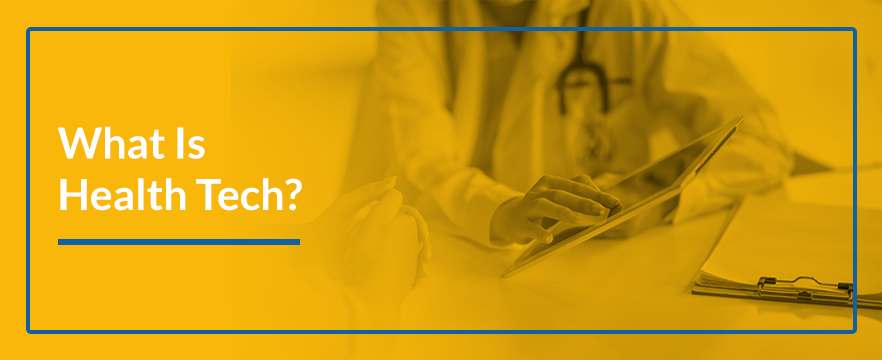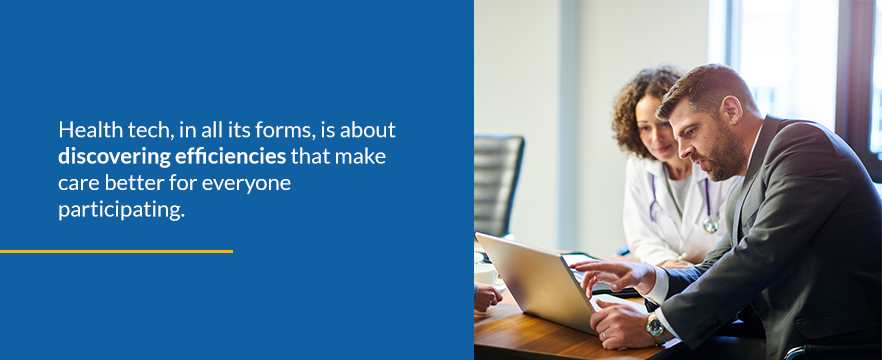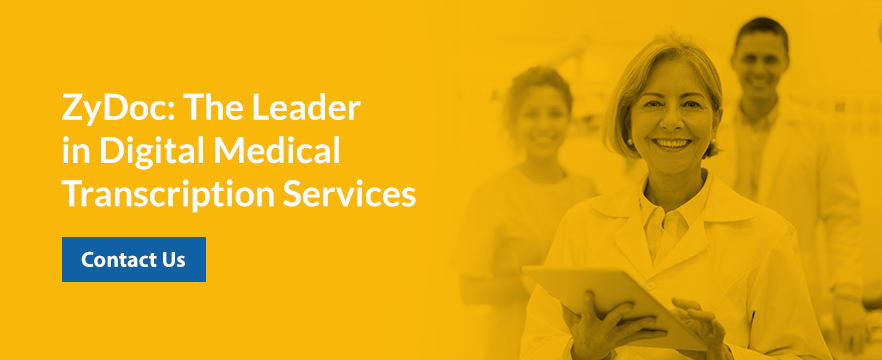What Is Health Tech?
Jan 09, 2020 | Jonathan Maisel
Healthcare is an immense industry, with global spending expected to top $10 trillion by 2022. For all its size and complexity, there are glaring issues with the system that create significant inefficiencies and make it harder for people to actually receive the quality of care they deserve. Healthcare technology, or “health tech,” is an emerging concept that has the power to radically change the way we deliver healthcare for the better.
Defining Health Tech
Health tech is the use of various technologies developed specifically for the healthcare industry to improve:
- Delivery of care
- Payment for services
- Consumption rates of care
What is health tech? Essentially, it is any use of medical technology to enhance any aspect of the healthcare process. One common question relates to the difference between health tech and med tech. The most straightforward differentiation is that med tech refers to the devices and software itself, whereas health tech encompasses the devices, as well as their uses.
For example, artificial intelligence (AI) and all its applications are health tech. When speaking about a specific AI product from a particular company, however, we’re talking about med tech. In some cases, the terms are interchangeable. In general, however, health tech is an umbrella term.
How Does Health Tech Impact the Medical Industry?
Health tech is quickly permeating almost every area of the medical industry. Several health tech applications affect the way patients and providers approach care. The primary practical uses of health tech lie in making care more straightforward for providers, and making it easier for patients to access care, as well as use their health information to improve outcomes. The following are three examples of the benefits of health tech for all involved.
1. Wearable Technology for Patient Monitoring
One notable advancement in the health tech industry is the use of wearable consumer technology for the remote monitoring of patients. A smartwatch can already help track a person’s heart rate over time, giving their physician a more accurate picture of that particular health metric.
The functionality of such devices continues to become more sophisticated. In the coming years, for example, consumer med tech may allow diabetics to monitor their blood sugar with their smartwatch as their glucose monitoring device.
2. Increased Use of Telehealth
Delivering care through digital means such as video conferencing is becoming one of the more common results of advancing health tech. Telemedicine can increase providers’ reach to patients who wouldn’t usually receive care. With tech like e-prescribing, telemedicine makes it easier for patients to receive care more efficiently and with less inconvenience.
Electronic health records, or EHRs, can contribute to telehealth as well, by offering patients portals they can use to view their health information and perform tasks like scheduling health appointments or requesting medication refills.
3. Greater Application of AI
Artificial intelligence may represent the most significant upcoming wave of health tech. As EHR technology continues to mature, it is inundating us with information on individuals and populations. AI can help us actually make sense of that information through deeper analysis and ultimately use it to drive better healthcare outcomes.
One example is the partnership between the Mayo Clinic and Google, where cloud data analytics, cloud computing, AI and machine learning will come together to benefit medical research.

How Does Health Tech Drive Innovation in the Medical Community?
Health tech, in all its forms, is about discovering efficiencies that make care better for everyone participating. With this industry becoming more and more valuable, creators of med tech are competing to create new technology and finding new uses for existing tech.
One instance is the combination of AI and robotics to enhance surgical speed and precision. In 2018, more than 5,000 surgical robots assisted 1 million procedures. The tech in these robots currently focuses on facilitating complex operations with minimal invasiveness, but it’s easy to see how the addition of AI could significantly expand their role in the coming years.
For example, a surgical robot with AI capabilities and access to a library of previous case information could evaluate a specific patient against prior data to give instant advice to the operating surgeon. This unification of technologies may come to represent full usage of ever-growing repositories of health data.
The number of prominent technology companies like Apple and Google that are delving into the health tech industry is so large that further partnerships like the one with the Mayo Clinic are almost inevitable. The promise of improved efficiency for providers and more safety for patients is more than enough to stimulate continued innovation in the healthcare industry.
Health Tech and Medical Transcription
EHRs have been a critical piece of health tech since the Health Information Technology for Economic and Clinical Health (HITECH) Act of 2009 incentivized providers to use them. The Act provided monetary motivation for demonstrating meaningful use of EHRs, leading to quick adoption.
Even though EHRs are one of the most notable examples of health tech in the past few decades, they have some usability issues that need addressing in order to achieve maximum efficacy. The No. 1 issue with EHRs is the need to type and click to enter data into the system. This necessity takes time away from doctors and patients, and can easily lead to burnout. The solution? Medical transcription.
Easy, Fast, Accurate Documentation
Medical transcription services are an efficient health tech solution that helps make EHRs as useful as possible by reducing the level of interaction required by physicians. Rather than engaging mostly with the computer, medical transcription allows doctors to take natural, intuitive notes through dictation to a device or a smartphone.
Compared to inaccurate speech recognition technology, medical transcription offers an accuracy rate of 99.6%, thanks to the use of human transcriptionists for the editing process. Additionally, taking notes verbally is 61% faster than using a keyboard and mouse to get information into a patient’s chart. In other words, medical transcription is both better for patients and a remarkable efficiency tool for clinicians.
A transcription service with EHR integration increases efficiency even further by eliminating the need to insert documentation manually. The physician only has to record the notes and send them off to the service. There is no easier way to take advantage of EHR technology while reducing the documentation burden on physicians.

ZyDoc: The Leader in Digital Medical Transcription Services
Digital medical transcription that’s designed for the modern medical professional is an excellent example of how health tech is improving healthcare efficiency, as well as the quality of care. Health tech is all about recognizing gaps in current technology and filling them, which digital medical transcription does at a competitive cost.
ZyDoc has been providing medical transcription solutions for more than 25 years and understands what doctors need from health tech like EHR integration. Browse our plans and pricing to see available features and start dictating unlimited notes free for 14 days, or call 1-800-546-5633 for more information.
